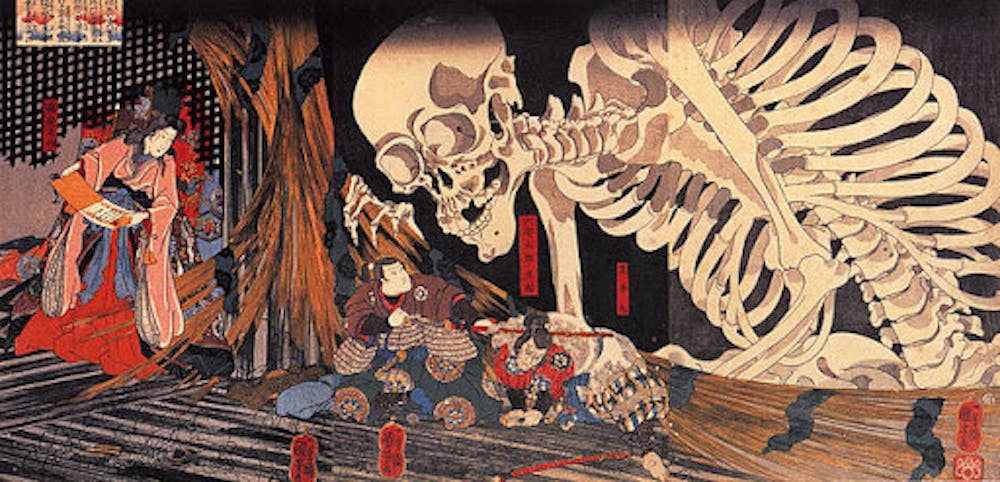By Lilly Ward
Staff Writer
It’s October, and suddenly all the skeletons are out of closets (physical ones–not metaphorical). They languish on porches and front steps, their plastic jaws unhinged as if surprised, their limp limbs dangling uselessly, eyeballs bulging in sockets that should be empty.
There’s something about the imagery of a skeleton that speaks to our fascination with the macabre. The image of the skeleton has a powerful history that has existed long before they became popular decorations for Halloween, revealing an overlap between art and science.
The fascination with what’s underneath the skin is believed to have started as early as the Babylon Empire. The first use of human dissection for medical education is mentioned in the Babylonian Talmud around 500 c.e. Eventually, this practice also existed in other parts of the ancient world such as Greece, and later Persia.
Although the practice of dissection was never widespread in the Ancient world, dissection of the human body was virtually nonexistent in the Middle Ages for religious reasons not just in Europe, but in Asia and in parts of the Islamic world. Dissection was believed to be a sin, an idea in part attributed to the Greek physician Galen's conception that the soul resided within the body.
It wasn’t until the 12th century that dissections began to gain popularity as an educational tool, and the dissection of executed criminals became sanctioned in late 13th-century and early 14th-century Europe. These events were often open to the public.
During the Renaissance, there was a renewed interest in understanding the human body, and the demand for bodies was steadily increasing although access to cadavers was still heavily restricted.
It was then no longer just physicians who wanted to get their hands on corpses. In order to create detailed and realistic depictions of the body, Italian Renaissance artists such as Giorgio Vasari, and later Leonardo Da Vinci and Michelangelo all employed dissection as a way to create authentic representations of the human body.
Sketches from this period depict bodies of all ages stripped down to gleaming muscles and skeletons, the corpses set against landscapes standing upright as if alive. Renaissance artists’ efforts greatly contributed to the quality of medical illustrations.
The work of Da Vinci was particularly influential. Frustrated by the lack of bodies available, Da Vinci went as far as to pay grave robbers to bring him cadavers. Known as a man of science as well as art, he dissected around 30 cadavers in his lifetime.
Da Vinci created a detailed study of a human skull in particular, lending his detailed approach to drawing the skull from multiple angles and perspectives. By the 15th century, the symbol of the skull had become a symbol of the fragility of human life, as well as the inevitability of death.
From the 17th to 19th century, the presence of skeletons in paintings served to remind viewers of their own mortality, a genre even developed known as “Vanitas,” which employed symbolism to convey the transitory nature of life. The study and popularity of skeletons in paintings continued well into the 19th century, as part of an artist’s formal education.
Van Gogh’s 1886 painting, “Skull of a Skeleton with Burning Cigarette,” just one of Gogh’s paintings featuring a skull, is believed to be from Gogh’s time at Royal Academy of Fine Arts in Antwerp, Belgium. While a study of the human form, this painting is also believed to be a result of Gogh’s own contemplation of death, as he was in poor health at the time of the painting.
Of course, the imagery of skeletons in art also exists outside of the Western canon, as early as the 10th century. A large skeleton, conjured by a princess, looms over a terrified man in an ukiyo-e woodblock triptych by Japanese artist Utagawa Kuniyoshi, who was renowned for his prints of historical and mythical scenes.
In this print created in 1844, Kuniyoshi depicts a real historical event in the 10th century which features the warlord Taira no Masakado’s daughter, Princess Takiyash. This scene depicts a rebellion in the 10th century.
The skeleton’s mythical presence is an example of a Gashadokuro, or a spirit in Japanese mythology, that takes the form of giant skeletons made of the skulls of people who died in battle.
Similarly, the Aztecs also used imagery of skeletons to depict mythological figures that represented death and rebirth. This imagery remains present in the celebration of the dead in Día de Muertos, a Mexican holiday in which ancestors are celebrated and honored, as well as in the work of the legendary artist Frida Kahlo.
Our preoccupation with skeletal structures represents more than just a desire to invoke the eerie and the frightening. From the desire to understand our inner workings, to meditating on the inevitability of our own demise, our skeletons attest to the curiosity and yearning within humanity. Plus, they also make great halloween decorations.
Vincent Van Gogh’s “Head of a Skeleton with burning cigarette” (1886) (courtesy of Wikimedia Commons, DcoetzeeBot, October 12, 2012).
Leonardo Da Vinci, “Anatomy of the Neck” (1512-1513) (courtesy of Wikimedia Commons, Maltaper, August 18, 2020).







